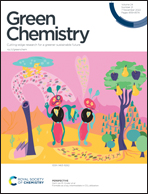Mechanically strong non-isocyanate polyurethane thermosets from cyclic carbonate linseed oil
Abstract
Non-isocyanate polyurethanes (NIPUs) from renewable resources have attracted much attention owing to their significant benefits towards sustainable development and green production. However, the low molar mass and poor mechanical properties of NIPUs greatly restrict their large-scale production and practical application as alternatives to conventional polyurethanes. In this study, a series of bio-based carbonated linseed oil (CLSO) films were synthesized via the carbon dioxide (CO2) coupling reaction of epoxidized linseed oil (ELSO) followed by efficient conversion into novel renewable NIPU thermosetting networks by curing CLSO with different diamines. In the coupling reaction between ELSO and CO2 (denoted as CO2@ELSO), the reactivity of epoxy groups at different sites on the ELSO was revealed by density functional theory (DFT) calculations. Furthermore, the reaction conditions for CLSO and NIPU films were optimized to achieve high atom efficiency and tailorable performance. The tensile strength of the resulting NIPU films was high up to 69.2 MPa and the elongation at breaking could be maintained at 15.4% due to their high crosslinking density and hydrogen bonding content. The novel bio-based NIPU materials developed in this work demonstrate various advantages, including excellent mechanical properties and thermal stability, which could find various applications in coatings, adhesives, elastomers and other industries.



 Please wait while we load your content...
Please wait while we load your content...